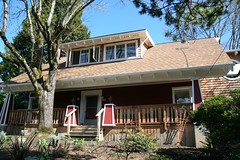Notes on Wood Floors Class
I went to the wood floors class last night and I’m pretty happy with it. I definitely have a better feel for the process and can hardly wait to actually have some floors that I can finish. Here are some interesting things that I learned.
The drum sander is easier than I thought. I played around with it and, although it really tugs when the drum is down, it’s not at all hard to get an evenly sanded surface. You just have to remember to be moving when you drop the drum, always walk at an even pace, and always lift the drum if you stop or need to change direction. He recommends that you break every room into two halves, start in the center, then move towards the wall you face. You want to sand each run twice, first forward, and then back. So, to recap, you turn the sander on, start walking, drop the drum, sand until you are close to the wall, then lift the sander, start walking backwards, then drop the drum and sand until you are roughly back at the center of the room. For new floors, I learned that, on the first pass with the 40 grit paper, you should sand the floors at a 45 degree angle to the boards. This will help to even the heights of the floor boards. This is only for the first pass. After you are done, you should sand again with the 40 grit parallel to the boards. All subsequent sanding with the finer grits should always be done parallel to the boards.
The edger wasn’t too hard either. It’s just a circular sander. It does fight a bit, like the drum sander, but it’s manageable. The instructor did say that it will ware out your back, since it involves a lot of bending over. I think I can manage the edger.
The buffer wasn’t too bad either. A few people had a hard time keeping it from running away from them, especially when they first turn it on. I found pretty quickly that it you rock it back and forward, by moving the handle up and down, that you can quickly find the balancing point and then control it from there. There was at least one woman who just couldn’t get the hang of it. She would turn it on and it would take off. So, she would quickly turn it off, drag it back to the center of the area, try again and it would take off again. I don’t think she ever got the hang of it. But, they also have a square vibrating buffer, which is easier to control, though they say it takes a lot longer to cover the same area as the circular buffer. I’ll probably get the circular buffer.
They didn’t spend much time with the finish, which was a bit of a disappointment since I’m more worried about it than the sanding. I probably should have written that in the class review form. He only had time to apply the sealer, though he said the subsequent two coats of finish is applied the same way. He did make it look easier than the video, using an applicator on a long pole. I’m going to follow them rather than the video. They did talk about the option of two different kinds of sealer. There is a water based sealer, which adds no color and leaves a natural wood look. And, there is an oil based sealer, which leaves a golden color. Although I’m inclined to use the water based, I did think the samples they had of the oil based did look nice. The instructor said this gives the floors a more classic look, since it is more like what they use to finish the floors with. So, I want a house that has a ‘classic’ look, but I also want the floors to match as close to the 1st floor as possible. I don’t know what was used on the first floor, but I would guess it was a water based sealer. Either way, the final two coats will be done with a water based polyurethane. I can hardly wait.

NOTE:Comments that appear to promote commercial web sites will be deleted.
0 Comments:
Post a Comment
<< Home